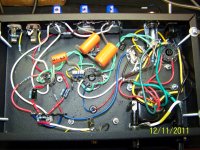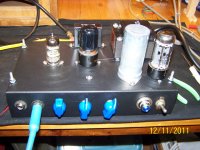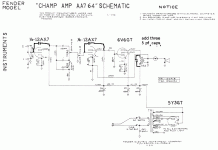I've just built my first amp from one of Tino Zottola books. A 764 Champ.
I carefully made sure all wiring was correct. He says in the book that the circuit is known to oscillate. And boy does it! I can change the pitch with the volume knob. He talks about supersonic oscillation. This is not supersonic. It is clearly audible. I've tried reversing the speaker wires and that did not do the trick.
He says to put a .005 uF cap across the output transformer and I'm waiting for one to come in. Any thoughts on the matter would be greatly appreciated. I have a scope but still learning how to use it.
Thanks in advance
I carefully made sure all wiring was correct. He says in the book that the circuit is known to oscillate. And boy does it! I can change the pitch with the volume knob. He talks about supersonic oscillation. This is not supersonic. It is clearly audible. I've tried reversing the speaker wires and that did not do the trick.
He says to put a .005 uF cap across the output transformer and I'm waiting for one to come in. Any thoughts on the matter would be greatly appreciated. I have a scope but still learning how to use it.
Thanks in advance
Attachments
Changing the primaries on the output trans did the trick. Thank you! The little amp sounds really good! Very low noise and has a really nice bite to it!
I'm noticing that when I turn the treble knob up all the way it starts to distort really bad. About 3/4's up to max. Not getting a great deal of change out of the bass or treble. The book calls for mylar tone caps and I used polypropylene orange drops because I had them laying around. I wonder if this could be the issue? Gonna have to read up on tone caps. It also wants a mylar cap for the coupling cap going to pin 5 of the Power tube. Can anyone tell me why this is? Thanks again. Once I get this amp all tweaked, I can not wait to start a bigger one.
I'm noticing that when I turn the treble knob up all the way it starts to distort really bad. About 3/4's up to max. Not getting a great deal of change out of the bass or treble. The book calls for mylar tone caps and I used polypropylene orange drops because I had them laying around. I wonder if this could be the issue? Gonna have to read up on tone caps. It also wants a mylar cap for the coupling cap going to pin 5 of the Power tube. Can anyone tell me why this is? Thanks again. Once I get this amp all tweaked, I can not wait to start a bigger one.
here you go man, rock-n-roll
3 - 5pf caps please if you have to go a little bit more aggressive 22pF
.005Uf is really hard into the audio range as 220 pf is the biggest I've ever installed as a rejection cap (across the output)
3 - 5pf caps please if you have to go a little bit more aggressive 22pF
.005Uf is really hard into the audio range as 220 pf is the biggest I've ever installed as a rejection cap (across the output)
Attachments
Last edited:
I want to congratulate you attempting one of the most difficult amps to work nicely.
This amp will sharpen your construction skills.
Pointers that will help you with this build and others tube Pt-Pt stuff
1 . twisty common powers coming of your power transformer. not only you can get to and identify, twisting help lower the electromagnetic interference radiating off the wire.
2. always try to keep lead length at a minimal. same reason as above.
3. try to keep the signal runs perpendicular to the heaters as possible.
lay out the tubes in such a fashion that there is little to no parallel heater/signal runs.
4. try to run power wires (b+, heater, bias) close to the chassis and if possible down the corner same reason above.
5. try to jacket leads of components with scrap stripped wire jackets to prevent short circuits. this amp is going to travel, and its like the old saying "an ounce of prevention is worth more than a pound of cure".
6. use "star" grounding method. jacks, everything that has a ground (even though its mounted to the chassis) run a wire to the one point and that point is bonded ground.
7. establish a bonded ground so that star grounding can turn the chassis as a shield. sand metal chassis clean approximately 1/4" around the circumference of the drilled hole for star ground. clean with rubbing alcohol.
8. when soldering, try to clench leads by wrapping them 3-5 times around terminal eyelets and 2-3 times around socket eyelets. this prevents parts from breaking off their termination during transport.
9. I strongly recommend using solid wire. it will give you the best workability with routing and soldering. Some people have claims of stranded wire, but there lack of proof and solid was and still the standard. The only wire that is stranded should be transformer wire leads if that. One person said to me about black jacket wire is no good. And I told him the only stuff I wire with is clothbound and the wire jacket I strip is white regardless of cloth covering color. So I can not prove/disprove this.
This amp will sharpen your construction skills.
Pointers that will help you with this build and others tube Pt-Pt stuff
1 . twisty common powers coming of your power transformer. not only you can get to and identify, twisting help lower the electromagnetic interference radiating off the wire.
2. always try to keep lead length at a minimal. same reason as above.
3. try to keep the signal runs perpendicular to the heaters as possible.
lay out the tubes in such a fashion that there is little to no parallel heater/signal runs.
4. try to run power wires (b+, heater, bias) close to the chassis and if possible down the corner same reason above.
5. try to jacket leads of components with scrap stripped wire jackets to prevent short circuits. this amp is going to travel, and its like the old saying "an ounce of prevention is worth more than a pound of cure".
6. use "star" grounding method. jacks, everything that has a ground (even though its mounted to the chassis) run a wire to the one point and that point is bonded ground.
7. establish a bonded ground so that star grounding can turn the chassis as a shield. sand metal chassis clean approximately 1/4" around the circumference of the drilled hole for star ground. clean with rubbing alcohol.
8. when soldering, try to clench leads by wrapping them 3-5 times around terminal eyelets and 2-3 times around socket eyelets. this prevents parts from breaking off their termination during transport.
9. I strongly recommend using solid wire. it will give you the best workability with routing and soldering. Some people have claims of stranded wire, but there lack of proof and solid was and still the standard. The only wire that is stranded should be transformer wire leads if that. One person said to me about black jacket wire is no good. And I told him the only stuff I wire with is clothbound and the wire jacket I strip is white regardless of cloth covering color. So I can not prove/disprove this.
Last edited:
Dave, I'm not having the oscillating issue anymore. Reversing the output primaries worked. The amp sounds great! Didn't need the .005 cap. Just having issues in the tone section as described. What is the purpose of the 3 5pf caps? I can only assume to block out frequencies? Or is there more to it?
Thanks
Thanks
Still tweaking
I've been re-studying about caps and I am lead to believe that the kind of caps I'm using is not the problem. As I said in an earlier post, everything is now sounding great until I crank the treble 3/4's the way up to max. At that point it starts to distort and break up really bad. Any ideas as what to look for?
I would really like to get this amp tweaked and all the bugs out before moving on to building a bigger one. Thanks in advance.
I've been re-studying about caps and I am lead to believe that the kind of caps I'm using is not the problem. As I said in an earlier post, everything is now sounding great until I crank the treble 3/4's the way up to max. At that point it starts to distort and break up really bad. Any ideas as what to look for?
I would really like to get this amp tweaked and all the bugs out before moving on to building a bigger one. Thanks in advance.
Comment about running down to RS for components is typical for a coastal inhabitant. Here in the middle, RS carries cell phones and toys, no parts. I find it more productive to cut up old televisions or video monitors for caps, sort them into bags by decade. Polyprophylene or mylar should make no difference, both are wound, differences are very subtle in frequency response at most. Anti-oscillation caps in feedback paths should be ceramic disk or for purists, silver mica, because of much lower self inductance of stacked caps. They are making stacked plastic insulator caps now for switcher power supplies like flourescent light bulbs, also a source of medium voltage caps. (200v, 400v). Haven't seen a discussion of merits/demerits of these.
Just a suggestion here, could try swapping the 12AX7 with a lower gain 12AU7. I read an article somewhere (will try to get it to you) that the design of the preamp stage on early Fender amps can get into overdrive and saturation at quite low settings of volume with the AX7. But maybe other people here have tried it..would be good to get some feedback from others.
I like the way the amp is sounding. It just breaks up when you turn the treble up all the way. But it may still be interesting to see what it sounds like with an AT....have to see if I have one... thanks.
Gonna try the grid stopper trick tomorrow.
And you're right Indianajo... I'm in the thumb... farm country... you're more likely to get farm equipment then capacitors at the Radio Shack here in Sandusky, Michigan. Went to the local music store for a midi cable. They didn't know what one was! I had to walk them over to a keyboard they had for sale and show them the midi jacks!!!!
Gonna try the grid stopper trick tomorrow.
And you're right Indianajo... I'm in the thumb... farm country... you're more likely to get farm equipment then capacitors at the Radio Shack here in Sandusky, Michigan. Went to the local music store for a midi cable. They didn't know what one was! I had to walk them over to a keyboard they had for sale and show them the midi jacks!!!!
By the way Dcline, I forgot to say that it is a really nice build! Like the point to point stuff. The oscillation problem you had at the begining happens a lot, 50-50 chance that the negative feedback (that is supposed to be there) turned into positive feedback when the phase of the output transformer is inversed..hence the full on squeeling. If you get a chance to post some picks if you are incorporating cabinet or head, please do
Comment about running down to RS for components is typical for a coastal inhabitant. Here in the middle, RS carries cell phones and toys, no parts. I find it more productive to cut up old televisions or video monitors for caps, sort them into bags by decade. Polyprophylene or mylar should make no difference, both are wound, differences are very subtle in frequency response at most. Anti-oscillation caps in feedback paths should be ceramic disk or for purists, silver mica, because of much lower self inductance of stacked caps. They are making stacked plastic insulator caps now for switcher power supplies like flourescent light bulbs, also a source of medium voltage caps. (200v, 400v). Haven't seen a discussion of merits/demerits of these.
A very minor point of clarification: Film caps are "wound" but almost never in an inductive way. The edges of the foil stick out, one plate's foil on each side of the roll, and the entire edge is connected to the lead, on each side of the roll. i.e. They don't connect just the end of each roll of foil to the leads. So those capacitors' only inductance is due to the distance between the leads, typically in the 2 nH to 10 nH range, or maybe a little more if they're very large caps. Polypropylene has much lower dielectric absorption than polyester (Mylar). So I always choose polypropylene over polyester if I can.
Last edited:
Well, the grid stoppers haven't solved my problem. I started with a 68k on the input and 1.5k up to 10k on the 6v6. It seemed like the breaking up got worse. Then I fried my output transformer.
Now...I'm running a little hotter power transformer then what the specs called for. The book I have called for a 600 V, 50ma and the closest I could find was a 650V at 70ma. Please excuse my ignorance... but could this have caused the problem? At this point I'm showing about 250 V on the 12AX7 plates when it should be around 200. Keep in mind that there is no continuity on the primary side of the OT.
I was really liking the way the amp was sounding as long as I didn't crank the Volume or Treble all the way up...
This is turning into a pricey learning experience.
Now...I'm running a little hotter power transformer then what the specs called for. The book I have called for a 600 V, 50ma and the closest I could find was a 650V at 70ma. Please excuse my ignorance... but could this have caused the problem? At this point I'm showing about 250 V on the 12AX7 plates when it should be around 200. Keep in mind that there is no continuity on the primary side of the OT.
I was really liking the way the amp was sounding as long as I didn't crank the Volume or Treble all the way up...
This is turning into a pricey learning experience.
- Status
- This old topic is closed. If you want to reopen this topic, contact a moderator using the "Report Post" button.
- Home
- Live Sound
- Instruments and Amps
- DIY Champ amp oscillation problem



 Per forum policy moved to the Instruments and Amps thread.
Per forum policy moved to the Instruments and Amps thread.